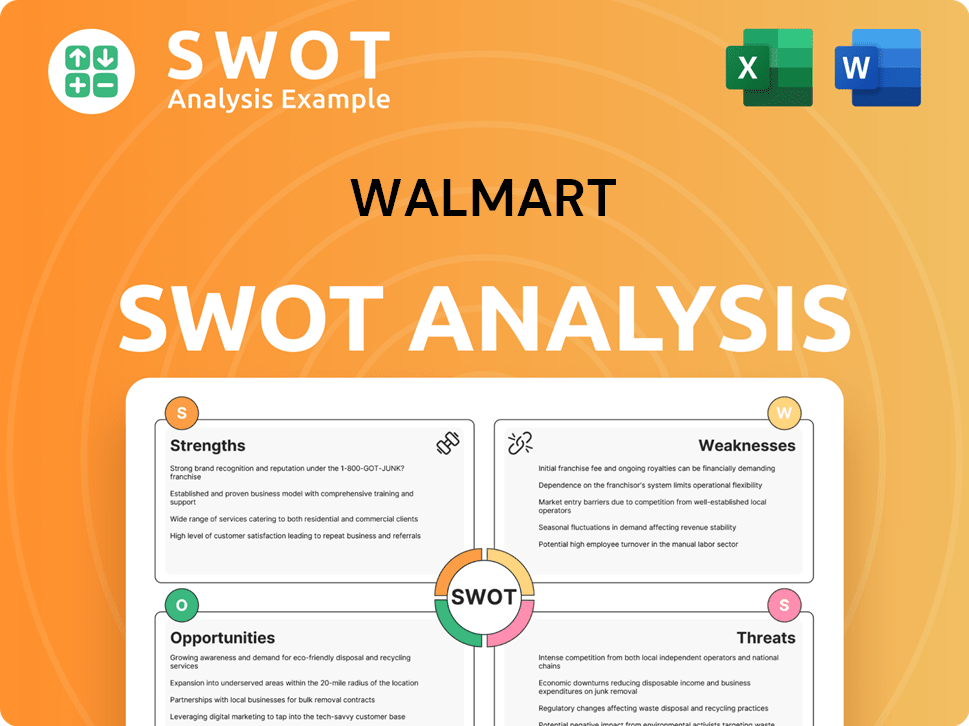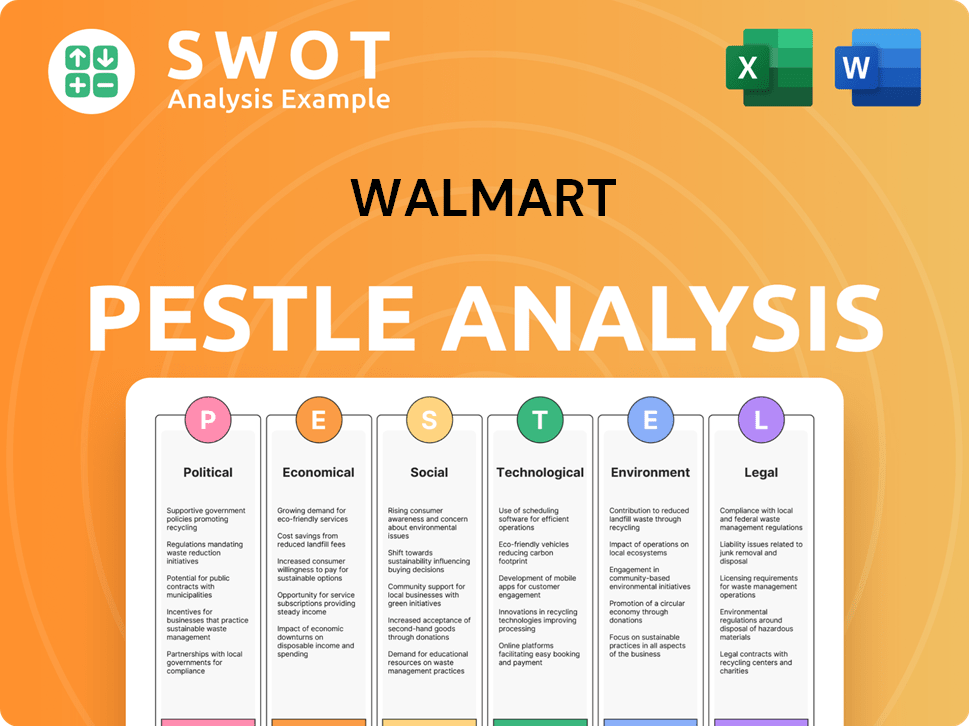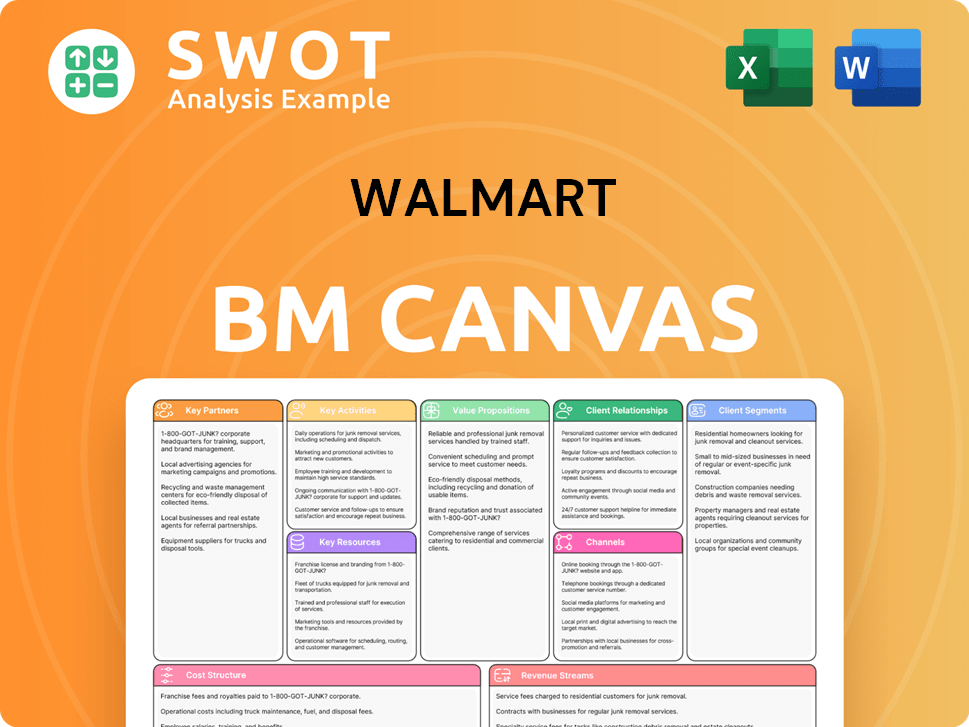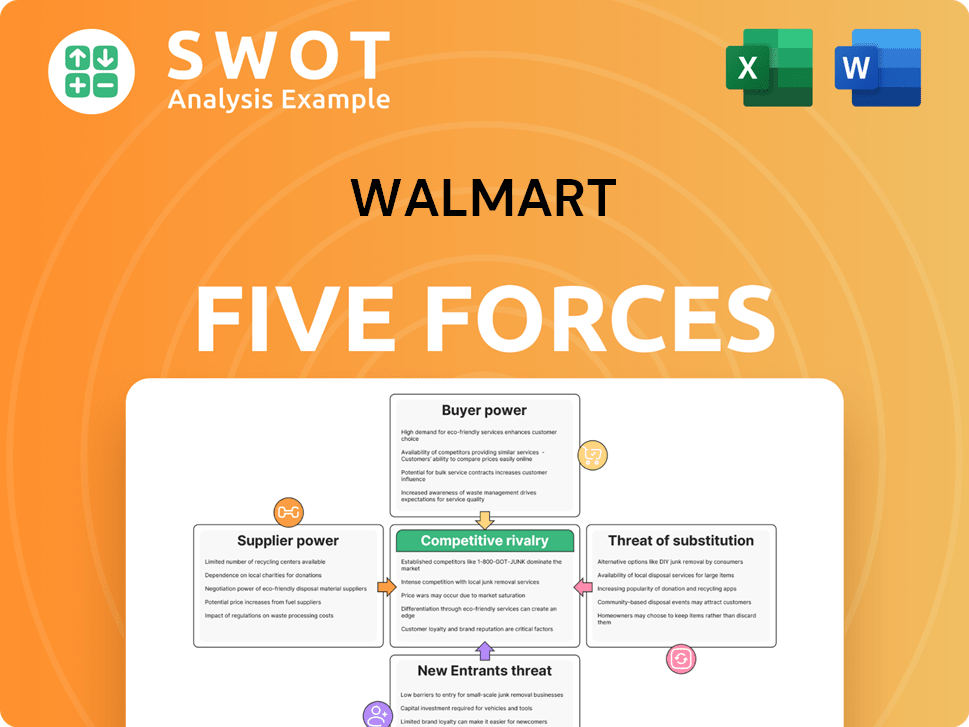Walmart Bundle
Who Shops at Walmart? Unveiling the Retail Giant's Customer Base
Understanding the Walmart SWOT Analysis is crucial to understanding its customer base. In the ever-evolving retail landscape, grasping customer demographics and target markets is key to success, especially for a behemoth like Walmart. This exploration delves into the heart of Walmart's strategy, examining who its customers are and how the company caters to their needs.

From its humble beginnings in rural Arkansas, Walmart has transformed, adapting its Walmart customer profile and Walmart market segmentation to meet the demands of a diverse global audience. This analysis will explore the customer demographics Walmart serves, including Walmart customer income levels, age demographics of Walmart shoppers, and Walmart's customer base ethnicity, providing insights into Walmart customer buying behavior and Walmart customer preferences and needs that drive its continued success. Understanding Walmart's target market is essential for anyone seeking to understand the retail industry.
Who Are Walmart’s Main Customers?
The primary customer segments for the company are exceptionally diverse, with a focus on price-conscious consumers seeking everyday low prices and convenience. The company employs a multifaceted segmentation strategy, incorporating demographic, geographic, behavioral, and psychographic factors to cater to its broad customer base. Understanding the Marketing Strategy of Walmart helps to further clarify their approach to customer demographics.
Demographically, the company primarily targets middle-income families, including working-class individuals, and budget-conscious consumers across different income levels who are looking for affordable products and value for their money. The typical customer is often described as a white baby boomer with an annual income of less than $80,000. The company's strategy has evolved to meet the changing needs of its customer base and adapt to market trends.
The company primarily serves consumers (B2C), offering a wide variety of products such as groceries, general merchandise, and health and wellness items. The company also targets small businesses, providing a one-stop shopping experience for their supplies and inventory needs. While the retailer caters to customers across different age groups, its primary focus is on middle-income families, and it has also put a particular emphasis on Generation X and Millennials for long-term loyalty.
The company's customer base includes a wide range of demographics, but it particularly focuses on middle-income families and budget-conscious consumers. These customers are often looking for affordable products and value for their money. The company's market segmentation strategy is designed to cater to this diverse customer base effectively.
The company's target market is exceptionally diverse, primarily appealing to price-conscious consumers seeking everyday low prices and convenience. The company uses a multifaceted segmentation strategy, including demographic, geographic, behavioral, and psychographic factors. This approach helps them to effectively reach and serve a broad customer base.
The company's customer base includes a wide range of income levels. While it caters to various income groups, it particularly focuses on middle-income families and budget-conscious consumers. This focus allows the company to offer affordable products and value for money to its customers.
The company caters to consumers across different age groups, with a primary focus on middle-income families. It has also put a particular emphasis on Generation X and Millennials for long-term loyalty. This shift in focus reflects the company's efforts to adapt to changing consumer preferences and market trends.
The company has seen a gain in market share, notably among households with incomes over $100,000, particularly through its online offerings and paid membership program, Walmart+. As of 2024, there are 31.8 million Walmart+ subscribers. This indicates a shift in target segments over time, prompted by new products, market research, and external trends like the increasing demand for e-commerce and convenience.
- The company's online presence and services have expanded to meet the growing demand for e-commerce.
- The company's paid membership program, Walmart+, has attracted a significant number of subscribers.
- The company's market share has increased among households with higher incomes.
- The company continues to adapt to changing consumer preferences and market trends.
Walmart SWOT Analysis
- Complete SWOT Breakdown
- Fully Customizable
- Editable in Excel & Word
- Professional Formatting
- Investor-Ready Format

What Do Walmart’s Customers Want?
Understanding the needs and preferences of its customers is crucial for the success of any retail giant, and this is especially true for the world's largest retailer. The company's customer base is diverse, but they are united by a few key priorities. These include value, convenience, and a broad selection of products, all of which influence their purchasing decisions.
In 2025, the company's customer base continues to be driven by the need for affordability. The 'Everyday Low Price' (EDLP) strategy is a core component of its appeal, with many shoppers actively seeking the best deals and discounts. Beyond price, convenience plays a significant role, with customers appreciating the ability to find a wide range of products under one roof, from groceries to electronics.
The company's customers are a diverse group, but understanding their needs allows the company to tailor its offerings and strategies effectively. By focusing on value, convenience, and a seamless shopping experience, the company aims to meet the evolving demands of its customer base and maintain its market leadership.
The company's customers are driven by key needs such as value, convenience, and affordability. Affordability remains the most important factor for 61% of customers surveyed in 2025. Convenience is also a major factor, with 70% valuing an easy-to-navigate website or app as a deciding factor for seamless shopping experiences. These preferences shape their purchasing behaviors and inform the company's strategies.
- Value and Affordability: Customers prioritize finding the best deals and discounts. The 'Everyday Low Price' (EDLP) policy directly appeals to this need.
- Convenience: Customers appreciate a one-stop shopping experience, finding a wide array of products under one roof.
- Seamless Shopping Experience: A hybrid approach to shopping is essential, with 45% of customers shopping both in-store and online.
- Online and In-Store Integration: Top motivators for customers include seamless online and in-store integration (66%), fast delivery options (64%), and flexible return policies (59%).
- Personalization: More than 55% of customers state that personalization plays a key role in their brand choices.
- Sustainability: 45% of customers are likely to choose products labeled as sustainable or eco-friendly.
Walmart PESTLE Analysis
- Covers All 6 PESTLE Categories
- No Research Needed – Save Hours of Work
- Built by Experts, Trusted by Consultants
- Instant Download, Ready to Use
- 100% Editable, Fully Customizable

Where does Walmart operate?
Walmart's geographical market presence is substantial, with over 10,500 stores and numerous e-commerce websites across 19 countries as of fiscal year 2024. The company's operations are segmented into Walmart U.S., Walmart International, and Sam's Club U.S., each contributing significantly to its global reach.
Walmart U.S. is the largest segment, boasting 4,605 stores across all 50 states, Washington D.C., and Puerto Rico. This extensive network includes Supercenters, Neighborhood Markets, and discount stores, strategically positioned to serve diverse customer needs. Walmart's ability to adapt to both suburban and rural areas, where shopping options may be limited, has solidified its market share and brand recognition.
Walmart International, with net sales of $114.6 billion for fiscal 2024, focuses on local relevance in markets like Canada, Mexico, Japan, China, and the United Kingdom. The company tailors its offerings and partnerships to succeed in diverse markets. For example, Walmart de México y Centroamérica operates in six countries, adapting its strategies to local preferences and leveraging local expertise. This approach is key to understanding Owners & Shareholders of Walmart and their strategic focus on market expansion.
Walmart U.S. strategically targets suburban and rural areas, where it often becomes the primary shopping destination. The company's comprehensive product range and competitive pricing have cemented its strong market share and brand recognition in these regions. For fiscal year 2025, Walmart U.S. had net sales of $462.4 billion, representing 69% of the company's consolidated net sales.
Walmart International emphasizes local relevance and customer focus in each market it serves. This includes adapting offerings, marketing, and partnerships to suit local preferences. Walmart plans to bring its 'View in Your Home' AR experience to Canada, Mexico, and Chile, enhancing the customer experience in these regions. By the end of 2025, the technology for personalized item recommendations from its U.S. website is expected to be used in Walmart International's Canada and Mexico markets.
Walmart plans to open five new stores and one new Sam's Club location by the end of September 2025 in the U.S., with approximately 10 new stores planned by the end of 2025. These new locations include Neighborhood Markets and Supercenters in various states. Walmart Canada announced a $6.5 billion investment over the next five years, including building dozens of new stores, with five new Supercenters in Ontario and Alberta by 2027. The Vaughan Distribution Centre is set to open in Spring 2025.
Walmart's strategy includes reaching urban customers through its extensive online presence, extending its accessibility beyond physical stores. This multi-channel approach allows Walmart to serve a broad range of customer demographics. Walmart's market segmentation is designed to cater to diverse needs, from groceries and electronics to clothing and household goods. Understanding the age demographics of Walmart shoppers is crucial for effective marketing strategies.
Walmart Business Model Canvas
- Complete 9-Block Business Model Canvas
- Effortlessly Communicate Your Business Strategy
- Investor-Ready BMC Format
- 100% Editable and Customizable
- Clear and Structured Layout

How Does Walmart Win & Keep Customers?
The strategies of customer acquisition and retention are crucial for the success of the company. The company focuses on attracting and keeping customers through a mix of traditional and digital marketing, as well as technological innovations. The core strategy, 'Everyday Low Prices' (EDLP), is consistently promoted to attract price-conscious consumers. This approach is central to understanding the Walmart customer profile.
The company utilizes a multi-channel marketing strategy that includes physical stores, e-commerce platforms, mobile apps, social media, and traditional advertising. Digital marketing is a significant component, with a strong online presence and targeted advertising to drive online sales. The company's data-driven advertising platform, helps to target campaigns effectively. Understanding the Walmart target market is key to the company's marketing efforts.
Customer retention is a priority, with the company aiming to build strong customer relationships and encourage repeat shopping. This involves personalized promotions and targeted advertising, often tailored by analyzing customer data and shopping patterns to match individual preferences. The company uses AI to personalize shopping experiences, detecting products likely to interest individual shoppers. This customer-centric approach is vital in analyzing Walmart consumer analysis and understanding Walmart shoppers.
The company uses a variety of channels to reach customers, including physical stores, e-commerce platforms, mobile apps, social media, and traditional advertising such as TV commercials and print media. This approach ensures broad reach and caters to different customer preferences.
A strong online presence is maintained with targeted advertising through websites, social media, and mobile applications. These efforts aim to engage customers and drive online sales. The company's advertising platform, helps in effectively targeting campaigns.
The company leverages AI to personalize shopping experiences by analyzing customer data, including previous purchases and browsing history. This helps in detecting products that are likely to interest individual shoppers. The company is accelerating its 'Adaptive Retail' strategy.
Loyalty programs, such as the Walmart+ membership, are key for customer retention. These programs provide exclusive savings, seamless return policies, and benefits like fuel discounts. These initiatives encourage repeat purchases and foster customer loyalty.
The company focuses on enhancing customer experience (CX) through data quality and generative AI to make it easier for customers to find products and receive tailored assistance. The company offers a wide array of products and lifestyle services to foster increased customer retention.
- In-store promotions, point-of-purchase displays, and product demonstrations drive product discovery and build trust.
- AI-powered chatbots on its website and mobile app handle queries and provide instant responses, freeing human agents for complex issues.
- The company's commitment to data-driven decision-making helps in understanding and meeting customer needs.
- Focusing on improving customer experience (CX) through data quality and generative AI is also a key retention strategy.
Walmart Porter's Five Forces Analysis
- Covers All 5 Competitive Forces in Detail
- Structured for Consultants, Students, and Founders
- 100% Editable in Microsoft Word & Excel
- Instant Digital Download – Use Immediately
- Compatible with Mac & PC – Fully Unlocked

Related Blogs
- What are Mission Vision & Core Values of Walmart Company?
- What is Competitive Landscape of Walmart Company?
- What is Growth Strategy and Future Prospects of Walmart Company?
- How Does Walmart Company Work?
- What is Sales and Marketing Strategy of Walmart Company?
- What is Brief History of Walmart Company?
- Who Owns Walmart Company?
Disclaimer
All information, articles, and product details provided on this website are for general informational and educational purposes only. We do not claim any ownership over, nor do we intend to infringe upon, any trademarks, copyrights, logos, brand names, or other intellectual property mentioned or depicted on this site. Such intellectual property remains the property of its respective owners, and any references here are made solely for identification or informational purposes, without implying any affiliation, endorsement, or partnership.
We make no representations or warranties, express or implied, regarding the accuracy, completeness, or suitability of any content or products presented. Nothing on this website should be construed as legal, tax, investment, financial, medical, or other professional advice. In addition, no part of this site—including articles or product references—constitutes a solicitation, recommendation, endorsement, advertisement, or offer to buy or sell any securities, franchises, or other financial instruments, particularly in jurisdictions where such activity would be unlawful.
All content is of a general nature and may not address the specific circumstances of any individual or entity. It is not a substitute for professional advice or services. Any actions you take based on the information provided here are strictly at your own risk. You accept full responsibility for any decisions or outcomes arising from your use of this website and agree to release us from any liability in connection with your use of, or reliance upon, the content or products found herein.